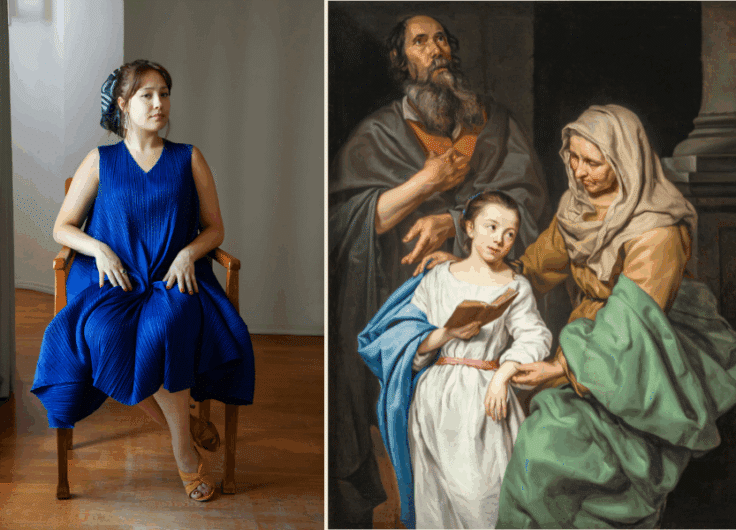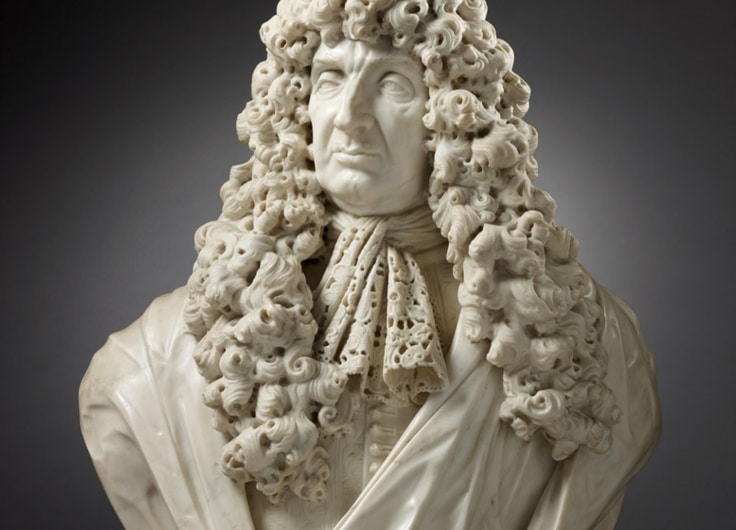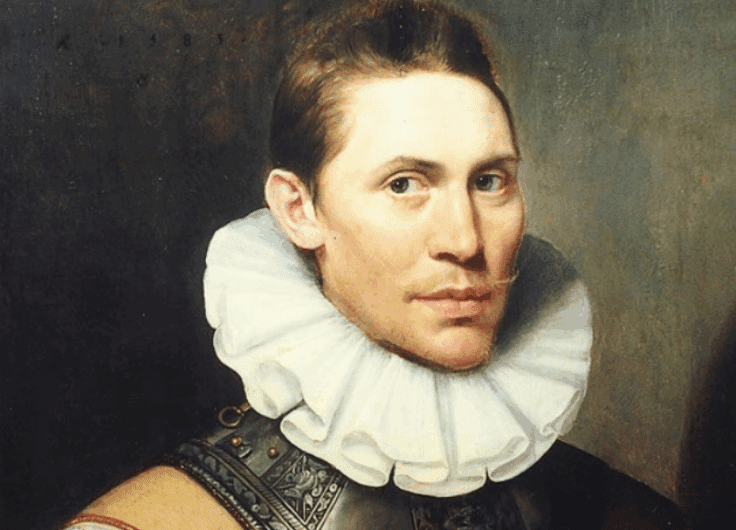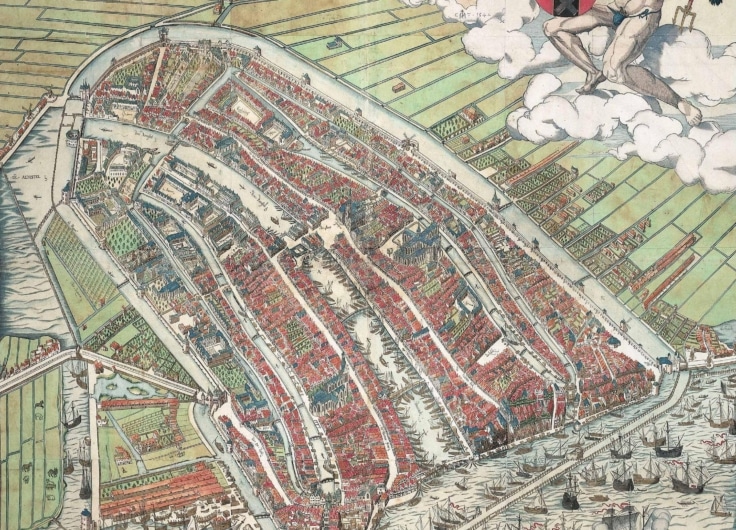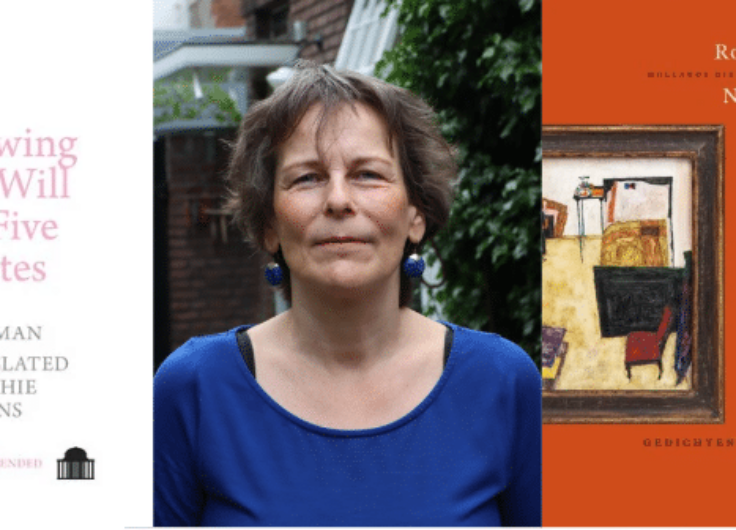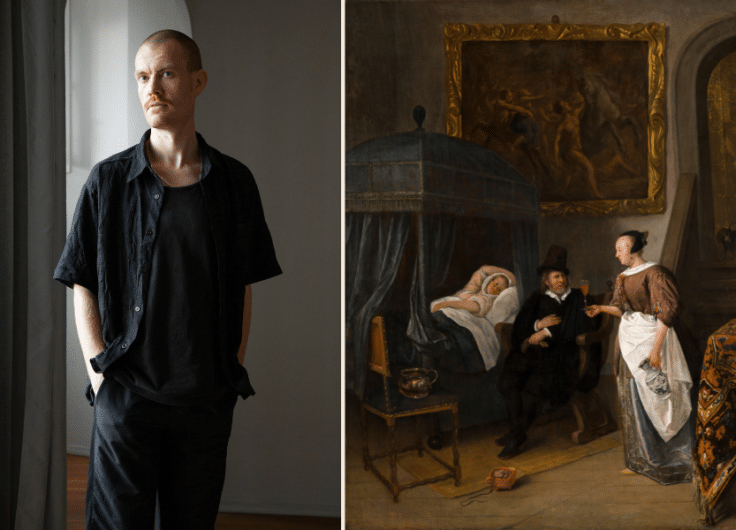Simon Stevin, Flemish Tutor to a Dutch Prince
Bruges engineer and mathematician Simon Stevin (1548-1620) is sometimes called the Leonardo Da Vinci of the Low Countries, for he is responsible for many revolutionary discoveries in physics, architecture, mathematics and linguistics.
Simon Stevin is best known for his introduction of decimal fractions, which later led to the establishment of the decimal system of weights and measures. But he was also the brains behind many technical inventions, of which the 28-passenger sailing chariot he built for use on the seashore was probably the best known to his contemporaries.
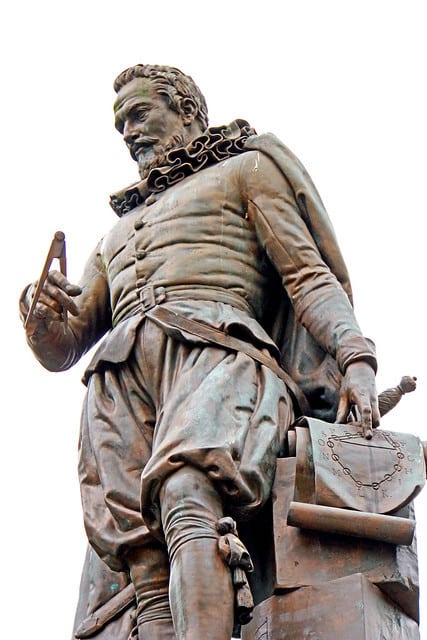 Statue of Simon Stevin by Louis Eugène Simonis, 1847, Bruges
Statue of Simon Stevin by Louis Eugène Simonis, 1847, BrugesFor those less familiar with Simon Stevin, he was born in Bruges in 1548, the illegitimate child of Anthuenis Stevin and Catelyne vander Poort. Recent research indicates his father may have been the youngest son of a mayor of Veurne. His mother was from a burgher family from leper (Ypres) with Calvinist leanings; she later married a merchant involved with the carpet-weaving and silk trades. Very little is known of Stevin’s youth and education. His first job was in Antwerp as a bookkeeper and cashier in one of the city’s trading houses, where he became acquainted with business practice and methods. In 1577 he accepted a post with the financial administration of the Brugse Vrije, the region around the city of Bruges. A few years later we find him registered in Leiden, in the present-day Netherlands. Exactly why he emigrated to the North is not known; perhaps he disliked the Spanish oppression of the southern part of the Low Countries, or he may have had Protestant sympathies. In 1583 Stevin’s name appears on the roll of the newly-founded University of Leiden, where the young Prince Maurits of Orange was attending courses.
A lifelong friendship developed between the two men. In Simon Stevin Prince Maurits found an excellent tutor and later a capable and loyal counsellor, while in return Stevin could count on the support and protection of his princely friend. When Maurits was elected Stadholder of Holland and Zeeland in 1584 he appointed Stevin to his personal service. According to some sources Stevin was Quartermaster-General of the State Army. A journal and a corresponding ledger have been discovered in the Rijksarchief (Public Record Office) in The Hague. The ledger, which dates from 1604, has been identified as Stevin’s practical application of his ideas on ‘princely’ bookkeeping; it includes an entry for Stevin’s annual salary of 600 Dutch guilders – a considerable sum which confirms Stevin’s high status at the Prince’s court.
In 1600, on the Prince’s initiative, Stevin founded a school of engineering at Leiden University; one unusual feature was that it offered courses taught in Dutch (‘Nederduyts’) rather than Latin. Several authors mention Stevin’s extensive travels throughout Europe; unfortunately, though, we have only indirect evidence for these, such as city and harbour plans to be found in his works. Of the many journeys he presumably made there is only one known record: a visit to Danzig (now Gdansk in Poland), where he was invited to provide expert advice on harbour works. In about 1614, at the age of 66, Stevin married the much younger Catharina Cray. The couple had four children: Frederic, Hendrik, Susanna and Levina. The second son, Hendrik, published some of his father’s works posthumously. Simon Stevin died in The Hague some time between 20 February and early April 1620, probably in the house on Raamstraat which he had purchased in 1612 for 3,800 Dutch guilders.
Engineer and scientist
Simon Stevin has always had a special place in the collective memory of the scientist people of the Low Countries, where there are many streets and squares named after him. In 1846 a bronze statue of him was unveiled in Brugge, his birthplace, amid great festivities. There are also a whole range of organisations that bear his name, including such diverse bodies as Simon Stevin sailing clubs in the Netherlands and in Belgium, a Simon Stevin student organisation for electromechanical engineers at the Technische Universiteit Eindhoven, several Simon Stevin observatories, a Simon Stevin technical institute for architecture, health sciences and management, as well as a Simon Stevin Foundation concerned with promoting the study, conservation and restoration of fortifications.
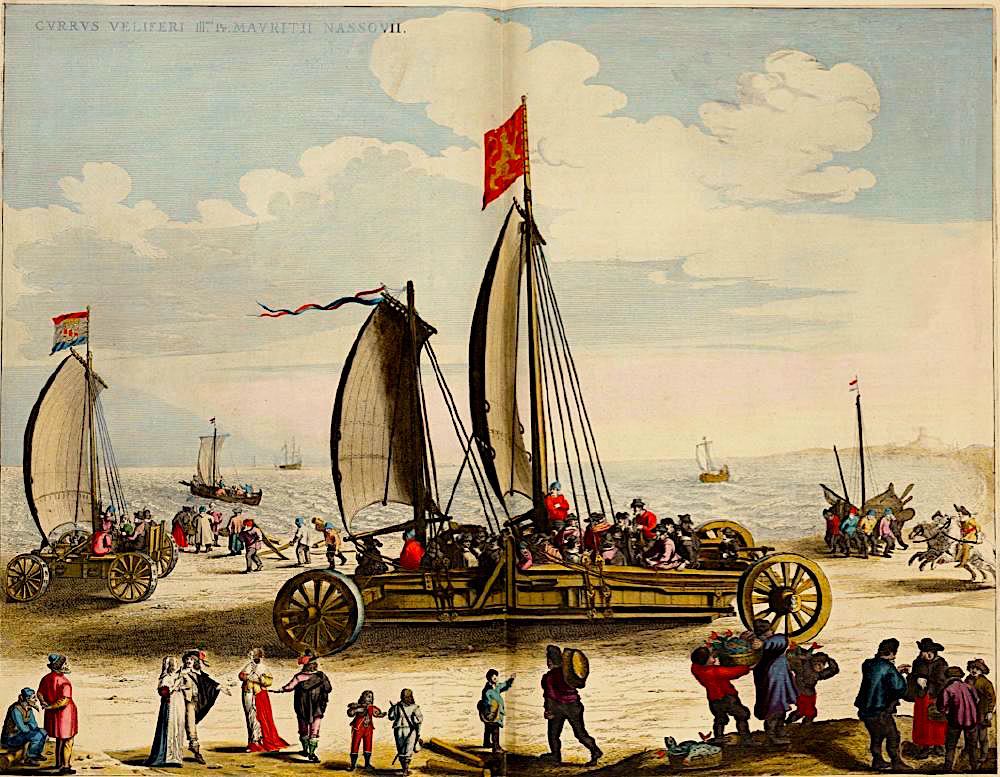 Simon Stevin built two sailing chariots for Prince Maurice. He used them on the beach to entertain his guests.
Simon Stevin built two sailing chariots for Prince Maurice. He used them on the beach to entertain his guests.© Wikipedia
In addition, Stevin’s influence can still be felt today in a variety of scientific organisations and instances. An international Simon Stevin exchange programme operates between eight History of Science Departments in the Netherlands, the United Kingdom and North America. Every year the Technologiestichting STW (Dutch Foundation for Technology) awards the prestigious title of Simon Stevin Meester (Simon Stevin Master) to an outstanding researcher in the field of technology. The individual so honoured also receives the generous sum of 1 million Dutch guilders. The education section of the BBC website devotes four pages to Stevin under the heading ‘local heroes’. Then there is the Belgian scientific journal `Simon Stevin, wis -en natuurkundig tijdschrift’ (Simon Stevin, Journal for Mathematics and Physics), now the Journal of the Belgian Mathematical Society.
Distinguished authors included Stevin, along with such eminent figures as Pascal, Babbage, Hollerith, von Neumann and Zuse, in a list of some ten individuals whose work, vision and technological skill made possible the development of modern computers; and his De Thiende (The Disme) features in the famous Philadelphia list Printing and the Mind of Man, which highlights books that have had an impact on the evolution of Western civilisation — one of only 65 books listed for the sixteenth century. To mark the 400th anniversary of Stevin’s birth in 1948 the Belgian Royal Academy of Sciences, Letters and Fine Arts devoted an entire 112-page issue of its journal to him. In 1995 an exhibition on Stevin’s works was held in the Biekorf, the city library of Brugge and home to many unique historical manuscripts. And in 1998 the Central Library of the Ghent University organised a Stevin exhibition, comparing works by him in the library’s possession with those of his contemporaries. The catalogues that accompanied these exhibitions provide a good overview of current knowledge about the great scholar and scientist. On 11 and 12 December 1998 a Simon Stevin Bruggelinck (Simon Stevin of Bruges) Symposium organised by the present authors and Dr C. van den Heuvel, then from The Hague but now in Maastricht, was held in Bruges, at which specialists from the Netherlands, Denmark and Belgium explored Stevin’s importance for science in general, for the liberal arts and for technology.
In the last fifty years there has been no shortage of publications devoted to Stevin. It would take too long to list them all, so we shall mention only a few important examples. One of the most famous Dutch historians of science, E.J. Dijksterhuis, together with some of his colleagues, produced a very extensive study of Stevin’s collected works in which a large part of his work is reproduced with a commentary and a modern English translation. Dirk Struik, a Dutch professor of mathematics at the Massachusetts Institute of Technology, gives his personal views on science in the Golden Age and also devotes a significant amount of space to Stevin. The volume Geschiedenis van de wetenschappen in België van de Oudheid tot 1815, (The History of the Sciences in Belgium from Ancient Times to 1815, published in 1998) deals extensively with Stevin s work, especially in the con- tribution by Prof. Paul Bockstaele.
Innovative ideas
 Title-page of De Beghinselen der Weeghconst (The Elements of the Art of Weighing), 1586)
Title-page of De Beghinselen der Weeghconst (The Elements of the Art of Weighing), 1586)© Wikipedia
Many of Stevin’s contributions and endeavours have long been recognised as pioneering or influential, and these still attract great interest today. One of the first books he published was Tafelen van Interest (Tables of Interest, 1582) which for the first time in Western Europe made interest tables available to all. Until then they had existed only in manuscript form, with copies being sold for very high prices to tradesmen, merchants and bankers. And Stevin was certainly the first to produce a complete description of decimal fractions and the operations that can be carried out with them in his pamphlet – mentioned above – entitled De Thiende (The Disme, 1585) in which he also dealt with their practical applications in surveying, the measurement of weights and the subdivision of money. Robert Norton’s English translation of the pamphlet, Disme, The Art of Tenths, or Decimall Arithmeticke. Invented by Simon Stevin (London, 1608), inspired Thomas Jefferson’s proposal of a decimal monetary unit for the new United States of America; to this day the tenth part of the American dollar is called a dime. The Scottish mathematician and theological writer John Napier also drew on Stevin’s work in his invention of logarithms.
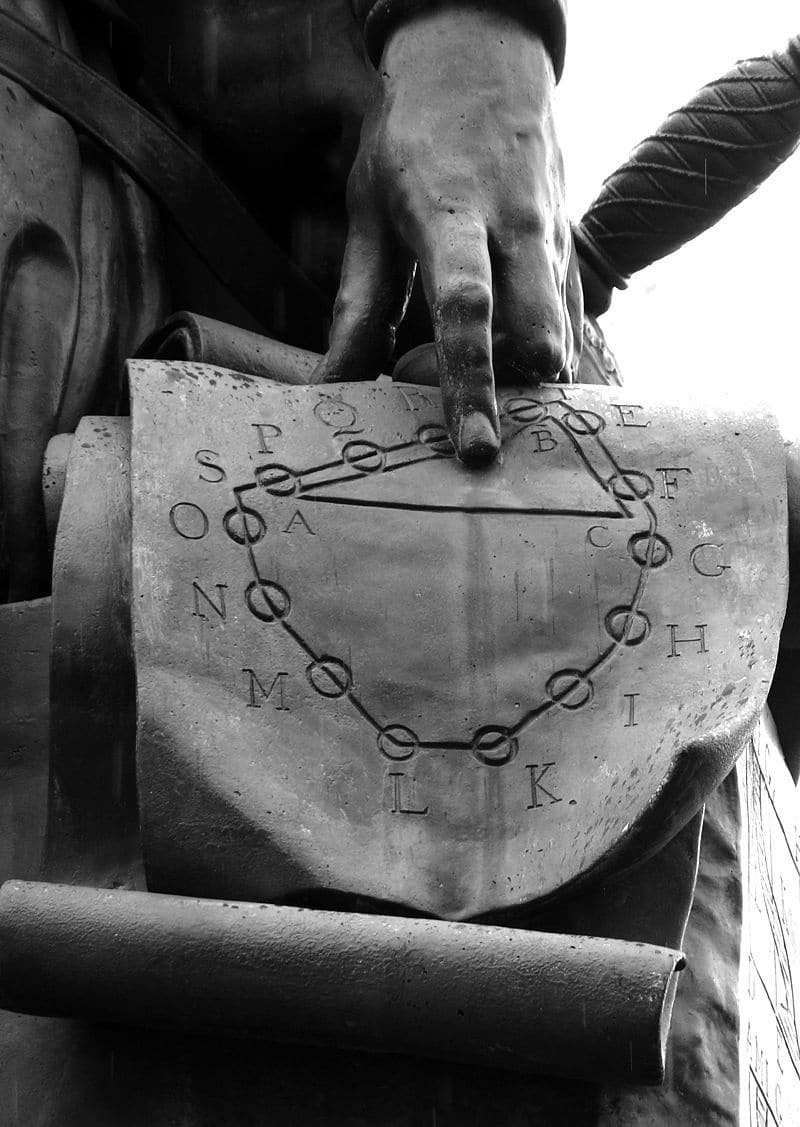 Detail of the Simon Stevin statue in Bruges, depicting the ‘clootcrans’ or ‘wreath of spheres’ theorem.
Detail of the Simon Stevin statue in Bruges, depicting the ‘clootcrans’ or ‘wreath of spheres’ theorem.© Wikipedia
In his works on physics Stevin was again a fount of new and innovative ideas. His De Beghinselen der Weeghconst (The Elements of the Art of Weighing, 1586) outlines the study of statics of rigid bodies. It contains the fabulous ‘clootcrans’ or ‘wreath of spheres’ theorem, a most ingenious thought-experiment by which one can find the condition of equilibrium of weights on different inclined planes. This theorem enabled Stevin to obtain the composition law of two concurrent forces by the parallelogram rule. In De Beghinselen des Waterwichts (The Elements of Hydrostatics, 1586) Stevin gave an improved demonstration of Archimedes’ law about the upward force acting on a body immersed in a liquid. He also succeeded in calculating the force exerted by a fluid on the bottom and walls of the vessel in which it is contained. And this led him to formulate the so-called hydrostatic paradox many years before Blaise Pascal, to whom it is usually attributed. In 1586 Stevin published his experiment in which two spheres of lead, one ten times as heavy as the other, were dropped from a church tower in Delft and fell 30 feet, according to his account, in the same time. Stevin’s report preceded Galileo’s first treatise on gravity by 3 years and his theoretical work on falling bodies by 18 years.
In the service of Maurits and the Republic
From 1590 onwards Stevin worked mainly in the service of Prince Maurits. Here the exhibition Maurits, prins van Oranje (Maurice, Prince of Orange) at the Rijksmuseum in Amsterdam has been very helpful, contributing to a better understanding of the interaction between Stevin and Maurits. The exhibition catalogue goes into considerable detail about their relationship. It would seem that from 1590 on most of Stevin’s publications were on topics of interest to Maurits or to the nation. In 1590 he published a pamphlet entitled Vita Politica, Het Burgherlick Leven (Civic Life) in which he sets out how a citizen, as a good subject, should comply with the rules laid down by the authorities. This was the time when the Republic of the Provinces of the Netherlands was being set up, and Stevin wrote his pamphlet inter alia in order to promote order and regularity. In the same spirit he published two books of practical use for the defence of the country and the expansion of the fleet.
In De Stercktenbouwing (The Building of Fortresses, 1594) he modified the new Italian system of fortification to suit the geographical conditions and available means of the Low Countries, with the result that his name is still associated with what is known as the ‘old Dutch’ method of fortification. This book was probably used as course material by the engineering school in Leiden. In the second book, De Havenvinding (The Haven-Finding Art, 1599) Stevin described how to determine a place’s location on the earth’s surface by knowing its geographical latitude and the magnetic variation of the compass needle. This method proved extremely valuable to the ships of the voc (The Verenigde Oost-Indische Compagnie, the Dutch East India Company), which had established a monopoly of trade between the (Far) East and Western Europe. Between 1605 and 16o8 the textbooks he had produced for Prince Maurits in numerous sciences (algebra, geography, astronomy, bookkeeping, statics and hydrostatics, perspective etc.) were collected and published under the title Wisconstige Gedachtenissen (Mathematical Memoirs). His last publication, in 1617, was a double volume: in Castrametatio, dat is Legermeting (Castrametatio, or the Marking out of Army Camps) he describes how to set up and equip a well-organised military camp, and in Nieuwe Maniere van Sterctebou door Spilsluysen (New Manner of Fortification Using Spindle-Sluices) how to use special sluices he had just invented in defensive works, mainly to maintain an appropriate depth of water in moats.
 Design of Stevin's fortifications of the German city of Moers
Design of Stevin's fortifications of the German city of Moers© Wikipedia
As well as the well-known aspects of his work, Stevin’ s less generally known contributions are now attracting increasing interest and appreciation. In his Van de Spiegeling der Singconst (Theory of the Art of Singing) – the manuscript of which was discovered in 1884 by Bierens de Haan – he was the first to propound a correct theory of the division of the octave into twelve equal intervals. In Van de Verschaeuwing (On Perspective), part of the Wisconstige Gedachtenissen, he was the first to build on the pioneering work of Guidobaldo del Monte. He devised new and fundamental theorems on projections, some of which can be found attributed to him in the works of celebrated mathematicians.
Considerable attention is also being paid to the influence of Stevin’s ideas on architecture, house-building and town planning. His thoughts on these subjects are set out in Van de Oirdening der deelen eens huys (House Planning) and Van de Oirdening der Steden (Town Planning) included in the Materiae Politicae, Burgherlicke Stoffen (Civic Matters, 1649) published by his son Hendrik. This material is only a small part of a projected much larger work entitled Huysbou (House – Building) that Stevin planned but never published. Sections of the hand-written manuscript of Huysbou were partially reproduced in the Journal of Isaac Beeckman and discovered in 1905 in the Rijksarchief (Public Record Office) of the Province of Zeeland in the Netherlands. They show the importance of Stevin’s ideas for the history of civil architectural techniques in his time.
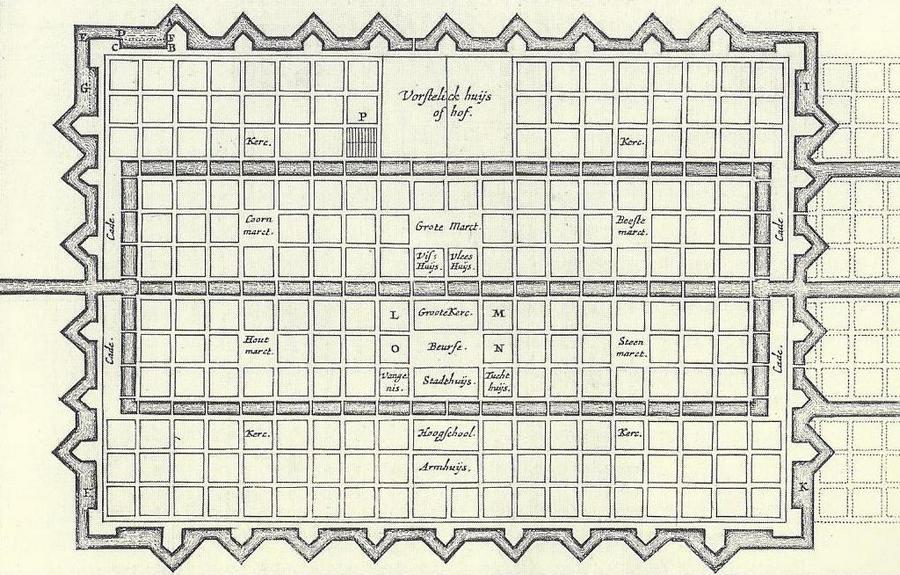 The ideal city according to Simon Stevin
The ideal city according to Simon StevinScientific and technical Dutch
Stevin published most of his works in Dutch, his mother tongue, rather than in Latin. His aim was to bring science and technology to people outside academic circles, who knew no Latin but had some understanding of the sciences or of technology. In the introduction to De Thiende he lists the categories of people for whom he wrote the pamphlet: star-gazers, surveyors, carpet-makers, wine-gaugers, mintmasters and merchants of all kinds. In his Uytspraeck vande Weerdicheyt der Duytsche Tael (Discourse on the Worth of the Dutch Language) written as an introduction to the Beghinselen der Weeghconst, Stevin outlined his views on his native language in some detail. In his opinion ‘Nederduytsch’ was exceptionally well-suited to expressing ideas, particularly scientific ideas, because of its short words and the readiness with which it formed word-combinations. Stevin deserves great credit for enriching the Dutch language by introducing new words or combining existing ones to translate their Latin counterparts. A typical example is the modern Dutch word for mathematics, ‘wiskunde’, which derives from Stevin’s ‘wisconst’. In 1992 M. Kool published a careful analysis of the neologisms and semantic neologisms introduced by Stevin in the field of arithmetic.
Stevin was highly esteemed not only by famous scientists but by his contemporaries, as is clear from the writings of Willebrord Snellius, William Gilbert, Isaac Beeckman, Constantijn and Christiaan Huygens and Adrianus Romanus (Adriaan van Roomen). This last praised Stevin for his statics and for his sailing chariot. Beeckman reproduced some of Stevin’s manuscripts, which he had borrowed from Stevin’s widow, in his Journal. Hugo de Groot or Grotius, the ‘father of international law’, was another who expressed great admiration for his work. In later times no lesser personages than Lagrange in his Traité de Mécanique analytique, Ernst Mach in Die Mechanik in ihrer Entwicklung historisch–kritisch dargestellt and Feynman in the famous Feynman Lectures referred admiringly to Stevin’s work.
In short, it is very clear that Simon Stevin occupies an important place in the history of the Low Countries and in the realms of science and technology, civic matters and also of music.
This article was previously published in the 2002 yearbook The Low Countries № 10.

